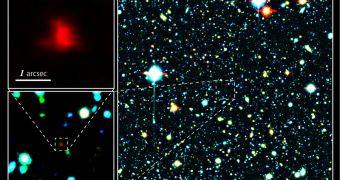In a paper to be published in the June 20 issue of the esteemed Astrophysical Journal, experts detail the discovery of what could very well be the oldest, most distant galaxy in the Universe. The object, entitled SXDF-NB1006-2, is located 12.91 billion light-years away from Earth.
The discovery is remarkable, astronomers say, primarily due to the fact that the old age of the galaxy indicates that it existed in the configuration we are currently seeing just 840 million years after the Big Bang. What this implies is that its stars appeared even sooner.
According to the most precise measurements of the Hubble constant, the Universe is about 13.75 billion years old. If the existence of the galaxy is confirmed, then it certainly is the most distant object of this type ever discovered.
It was imaged using the California Association for Research in Astronomy's 10-meter twin W. M. Keck Observatory telescopes and the National Astronomical Observatory of Japan's 8.2-meter Subaru Telescope, all three located at the Mauna Kea Observatory, in Hawaii.
According to astronomers who've had a chance to look over the new data, this galaxy is among the first ever to appear. There is no way to be certain whether it was the first or not, but it was definitely there shortly after the Big Bang.
It's objects like SXDF-NB1006-2 that can make or break theories on the beginnings of the Universe, scientists say. The most distant objects out there are the most difficult to detect and study, but also the most likely to answer some of the most difficult questions in astronomy today.
“The day is not so far off when the mysteries of the dark ages of the Universe and the physical properties of the first galaxies will be revealed,” explains the leader of the NAOJ Thirty Meter Telescope (TMT) project, Masanori Iye, quoted by Space.
Over the past few months, teams working at the University of Arizona and with the NASA/ESA Hubble Space Telescope have also announced the discovery of distant galaxies, 13 and 13.2 billion light-years away, respectively.
However, the Hubble galaxy has not been confirmed by other studies as of yet. Until further notice, it remains nothing more than a candidate galaxy.

 14 DAY TRIAL //
14 DAY TRIAL //